Related Research Articles
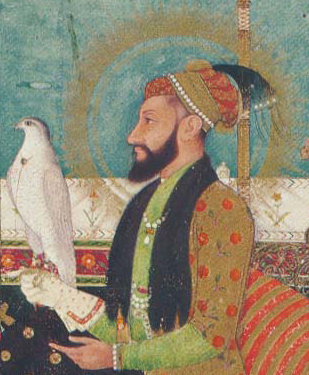
Muhi al-Din Muhammad, commonly known as Aurangzeb and by his regnal title Alamgir, was the sixth emperor of the Mughal Empire, ruling from July 1658 until his death in 1707. Under his emperorship, the Mughals reached their greatest extent with their territory spanning nearly the entirety of South Asia.
Mughal or Moghul may refer to:

The Taj Mahal is an Islamic ivory-white marble mausoleum on the right bank of the river Yamuna in the Indian city of Agra. It was commissioned in 1631 by the Mughal emperor Shah Jahan to house the tomb of his favourite wife, Mumtaz Mahal; it also houses the tomb of Shah Jahan himself. The tomb is the centrepiece of a 17-hectare (42-acre) complex, which includes a mosque and a guest house, and is set in formal gardens bounded on three sides by a crenellated wall.
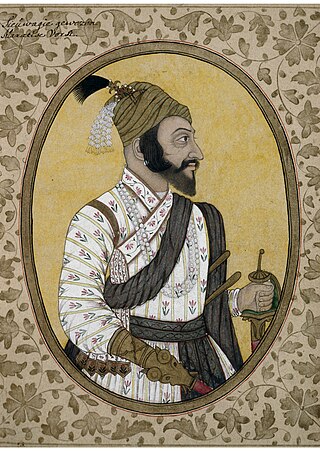
Shivaji Bhonsale I, also referred to as Chhatrapati Shivaji Maharaj, was an Indian ruler and a member of the Bhonsle Maratha clan. Shivaji carved out his own independent kingdom from the declining Adilshahi sultanate of Bijapur which formed the genesis of the Maratha Empire. In 1674, he was formally crowned the Chhatrapati of his realm at Raigad Fort.

Bahadur Shah II, usually referred to by his poetic title Bahadur Shah Zafar was born Mirza Abu Zafar Siraj-ud-din Muhammad and was the twentieth and last Mughal Emperor as well as an Urdu poet. He was the second son and the successor to his father, Akbar II, who died on 28 September 1837. He was a titular Emperor, as the Mughal Empire existed in name only and his authority was limited only to the walled city of Old Delhi (Shahjahanbad). Following his involvement in the Indian Rebellion of 1857, the British exiled him to Rangoon in the British-controlled Burma in 1858, after convicting him on several charges.

The Mughal emperors were the supreme heads of state of the Mughal Empire on the Indian subcontinent, mainly corresponding to the modern countries of India, Pakistan, Afghanistan and Bangladesh. The Mughal rulers styled themselves as Badshah or Shahanshah, a title usually translated from Persian as "emperor". They began to rule parts of India from 1526, and by 1707 ruled most of the sub-continent. After that they declined rapidly, but nominally ruled territories until the Indian Rebellion of 1857.

Mughal-e-Azam is a 1960 Indian epic historical drama film produced and directed by K. Asif. Starring Prithviraj Kapoor, Dilip Kumar, Madhubala, and Durga Khote, it follows the love affair between Mughal Prince Salim and Anarkali, a court dancer. Salim's father, Emperor Akbar, disapproves of the relationship, which leads to a war between father and son.

Guru Gobind Singh, born Gobind Das or Gobind Rai the tenth Sikh Guru, a spiritual master, warrior, poet and philosopher. When his father, Guru Tegh Bahadur, was executed by Aurangzeb, Guru Gobind Singh was formally installed as the leader of the Sikhs at the age of nine, becoming the tenth and final human Sikh Guru. His four biological sons died during his lifetime – two in battle, two executed by the Mughal governor Wazir Khan.
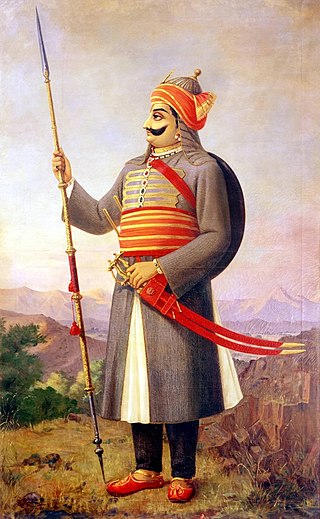
Pratap Singh I, popularly known as Maharana Pratap, was a king of Mewar from the Sisodia dynasty. Pratap became a folk hero for his military resistance against the expansionism of the Mughal Empire under Akbar through guerrilla warfare which proved inspirational for later rebels against Mughals including Shivaji.

The Red Fort or Lal Qila is a historic fort in Old Delhi, Delhi in India that served as the main residence of the Mughal Emperors. Emperor Shah Jahan commissioned construction of the Red Fort on 12 May 1638, when he decided to shift his capital from Agra to Delhi. Originally red and white, its design is credited to architect Ustad Ahmad Lahori, who also constructed the Taj Mahal. The fort represents the peak in Mughal architecture under Shah Jahan and combines Persianate palace architecture with Indian traditions.

Medieval India refers to a long period of Post-classical history of the Indian subcontinent between the "ancient period" and "modern period". It is usually regarded as running approximately from the breakup of the Gupta Empire in the 6th century CE to the start of the Early modern period in 1526 with the start of the Mughal Empire, although some historians regard it as both starting and finishing later than these points. The medieval period is itself subdivided into the Early Medieval and Late Medieval eras.

Mughal painting is a style of painting on paper confined to miniatures either as book illustrations or as single works to be kept in albums (muraqqa), from the territory of the Mughal Empire in South Asia. It emerged from Persian miniature painting and developed in the court of the Mughal Empire of the 16th to 18th centuries. Battles, legendary stories, hunting scenes, wildlife, royal life, mythology, as well as other subjects have all been frequently depicted in paintings.

Nihari is a stew originating in Lucknow, the capital of 18th-century Awadh under the Mughal Empire in the Indian subcontinent. It consists of slow-cooked meat, mainly a shank cut of beef, lamb and mutton, or goat meat, as well as chicken and bone marrow. It is flavoured with long pepper, a relative of black pepper.
A Subah was the term for a province (State) in the Mughal Empire. The word is derived from Arabic and Persian. The governor/ruler of a Subah was known as a subahdar, which later became subedar to refer to an officer in the Indian Army and Pakistan Army. The subahs were established by badshah (emperor) Akbar during his administrative reforms of years 1572–1580; initially they numbered to 12, but his conquests expanded the number of subahs to 15 by the end of his reign. Subahs were divided into Sarkars, or districts. Sarkars were further divided into Parganas or Mahals. His successors, most notably Aurangzeb, expanded the number of subahs further through their conquests. As the empire began to dissolve in the early 18th century, many subahs became effectively independent, or were conquered by the Marathas or the British.
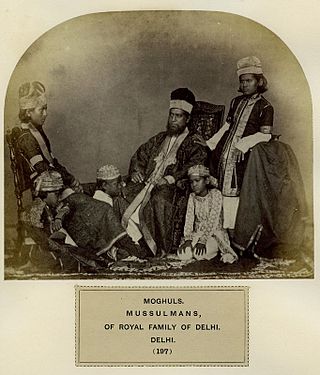
The Mughals are a number of culturally related clans of Indo-Turkic people in North India, Pakistan and Bangladesh. They claim they are descended from the various Central Asian Mongolic and Turkic tribes and Persians that settled in the region. The term Mughal literally means Mongol.

Abu'l-Fath Jalal-ud-din Muhammad Akbar, popularly known as Akbar the Great, and also as Akbar I, was the third Mughal emperor, who reigned from 1556 to 1605. Akbar succeeded his father, Humayun, under a regent, Bairam Khan, who helped the young emperor expand and consolidate Mughal domains in India.

The Mughal Empire was an early-modern empire that controlled much of South Asia between the 16th and 19th centuries. For some two hundred years, the empire stretched from the outer fringes of the Indus river basin in the west, northern Afghanistan in the northwest, and Kashmir in the north, to the highlands of present-day Assam and Bangladesh in the east, and the uplands of the Deccan Plateau in South India.

The Bengal Subah, also referred to as Mughal Bengal, was the largest subdivision of the Mughal Empire encompassing much of the Bengal region, which includes modern Bangladesh and the Indian state of West Bengal, Indian state of Bihar, Jharkhand, Odisha between the 16th and 18th centuries. The state was established following the dissolution of the Bengal Sultanate, a major trading nation in the world, when the region was absorbed into one of the gunpowder empires. Bengal was the wealthiest region in the Indian subcontinent, due to their thriving merchants, Seth's, Bankers and traders and its proto-industrial economy showed signs of driving an Industrial revolution.

The Subah of Multan or Multan Province was a subdivision of the Mughal Empire, one of the original twelve provinces of Mughals ,encompassing the southern Punjab region, stretching towards parts of Khyber, Central Punjab and Balochistan, bordering Kandahar Province and Persian Safavid Empire. It was one of the largest and important provinces of Mughal Empire.
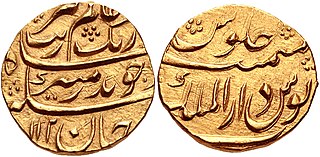
The economy of the Mughal Empire was very large and prosperous. The gross domestic product (GDP) of the Mughal Empire in 1600 was estimated at 22% of the world economy, the second largest in the world, behind only Ming China but larger than Europe. By 1700, the GDP of Mughal India had risen to 24% of the world economy, the largest in the world, larger than both Qing China and Western Europe. The Mughal empire was producing about 25% of the world's industrial output up until the 18th century. India's GDP growth increased under the Mughal Empire, with India's GDP having a faster growth rate during the Mughal era than in the 1,500 years prior to the Mughal era. Mughal India's economy has been described as a form of proto-industrialization, like that of 18th-century Western Europe prior to the Industrial Revolution.
References
- ↑ admin (2016-04-23). "The costume of Mughal period". www.josbd.com. Retrieved 2021-01-19.
